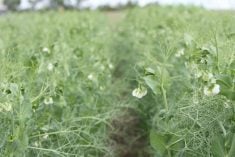The U.S. Weather Service predicts that strong El Nino conditions will persist into the April to June period.
El Nino is the name given to the situation when water temperature in the Pacific Ocean’s equatorial region warms. It has a range of impacts through Asia, Australia and North and South America.
The El Nino has contributed to the wet weather in South America, which is prompting expectations of a bumper soybean harvest there.
El Nino usually means a mild winter on the Canadian Prairies, but as Ed White reported in the Jan. 14 edition of The Western Producer, the less-known arctic oscillation trumped El Nino’s effects in Canada through December until it weakened and allowed the mild weather of mid-January.
Read Also

Phosphate prices to remain high
Phosphate prices are expected to remain elevated, according to Mosaic’s president.
The El Nino was blamed for the disappointing monsoon in the Indian subcontinent that reduced India’s summer crop.
However, good rain in the final weeks of the monsoon season late last fall prompted India’s farmers to increase winter seeding and so far that crop, which includes the big chickpea crop, is developing nicely.
The chickpea area as of Jan. 21 stood at 21.45 million acres, up from 20.34 million at the same point last year. The larger area and better weather is reducing fears about supply of food staples such as chickpeas. This price in India has dropped about 20 percent since peaking in November.
However, across the border in Pakistan it continues dry.
Traders there already say the country will not repeat 2009’s big wheat crop of 24 million tonnes. They put this year’s wheat crop at 19 to 20 million tonnes, well short of 22 million tonnes the country consumes annually.
The country has reserves after its big crop last year, but might have to import in 2011.
Pakistan is a growing market for Canadian crops. Last crop year, it imported 247,500 tonnes of wheat from Canada, 385,000 tonnes of canola and 20,000 tonnes of peas.
El Nino’s effects do not stretch to Turkey, the world’s third largest lentil producer after India and Canada and a key competitor in the world market.
Saskatchewan Pulse Growers reports that seeded area of red lentils in Turkey is in line with recent production trends. Weather has been good, and the production forecast is for 420,000 tonnes when applying historical average yields.
Getting back to Canada, Bruce Burnett, the Canadian Wheat Board’s director of weather and market analysis, says El Nino tends to cause drier winters in Western Canada, and that was the case from October to the middle of this month when Manitoba, Saskatchewan and eastern Alberta were extremely dry. This past weekend’s blizzard will have changed the picture somewhat.
If a strong El Nino persists into spring, it tends to produce moisture and cooler-than-normal conditions, and that could help make up for the dry winter.














